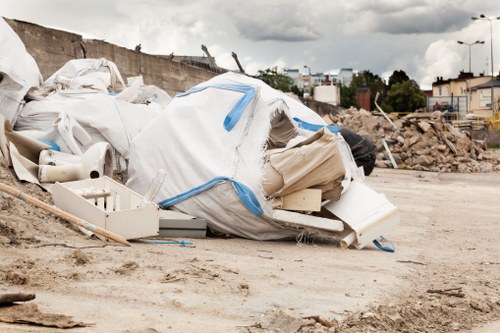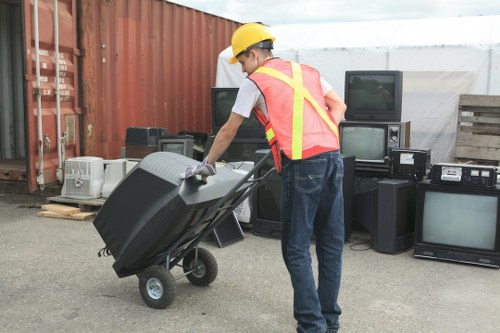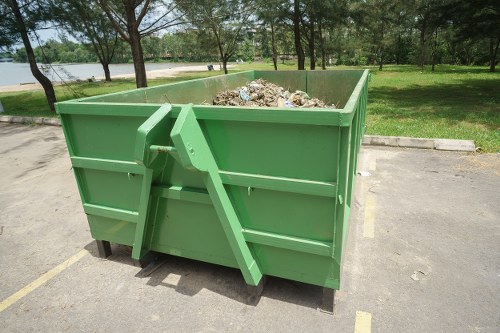Loft Clearance in Commercial Waste Disposal
Understanding Loft Clearance in Commercial Settings

Commercial loft clearance is a specialized service focused on the efficient removal and disposal of unwanted items from office lofts, warehouses, and other commercial properties. This process not only helps in maintaining a clutter-free environment but also ensures that waste is handled responsibly.
Effective loft clearance is essential for businesses seeking to optimize their storage spaces. By clearing out unnecessary items, companies can enhance their operational efficiency and create a more organized workspace.
Moreover, commercial loft clearance plays a significant role in sustainability efforts. Proper disposal and recycling of materials contribute to reducing the environmental footprint of businesses.
The Importance of Effective Waste Disposal

Effective waste disposal in loft clearance is crucial for several reasons. Firstly, it ensures compliance with local regulations and environmental standards. Improper disposal can lead to hefty fines and legal repercussions for businesses.
Secondly, responsible waste management enhances a company's reputation. Clients and partners are more likely to engage with businesses that demonstrate a commitment to sustainability and ethical practices.
Furthermore, efficient waste disposal can lead to cost savings. By recycling and reusing materials, businesses can reduce their overall waste management expenses.
Types of Waste Typically Found in Loft Clearance

During commercial loft clearance, various types of waste are commonly encountered. These include:
- **Office Equipment:** Old computers, printers, and other electronic devices.
- **Furniture:** Desks, chairs, shelves, and other office furnishings.
- **Packaging Materials:** Cardboard boxes, plastic wraps, and other packing supplies.
- **Hazardous Waste:** Batteries, chemicals, and other materials that require special handling.
- **General Waste:** Paper, textiles, and other non-recyclable items.
Identifying the types of waste is the first step in determining the appropriate disposal methods. This ensures that each item is handled correctly, minimizing environmental impact.
Choosing the Right Commercial Waste Disposal Service

Selecting a reliable commercial waste disposal service is vital for successful loft clearance. Here are key factors to consider:
- Experience: Opt for companies with a proven track record in commercial waste management.
- Compliance: Ensure the service provider adheres to all local and national disposal regulations.
- Recycling Capabilities: Choose services that emphasize recycling and sustainable disposal practices.
- Flexibility: The ability to handle varying volumes and types of waste is essential.
- Cost-Effectiveness: Compare pricing to find a service that offers quality without exorbitant costs.
By carefully evaluating these factors, businesses can partner with a disposal service that meets their specific needs and standards.
Steps Involved in Loft Clearance Process

The loft clearance process typically involves several key steps to ensure efficiency and compliance:
- Assessment: Evaluating the scope of the clearance and identifying the types of waste involved.
- Planning: Developing a strategic plan for the removal and disposal of items.
- Execution: Carrying out the physical removal of waste from the loft space.
- Sorting: Categorizing waste for recycling, reuse, or proper disposal.
- Disposal: Transporting and disposing of waste according to regulatory standards.
Following these steps ensures a systematic approach to loft clearance, minimizing disruptions to business operations.
Environmental Considerations in Waste Disposal
Environmental sustainability is a critical aspect of commercial waste disposal. Businesses must prioritize eco-friendly practices to mitigate their impact on the planet.
Implementing recycling programs and reducing non-recyclable waste are effective strategies. Additionally, partnering with disposal services that focus on sustainable methods further enhances environmental responsibility.
By adopting green waste management practices, companies contribute to the preservation of natural resources and support global sustainability goals.
Cost Factors in Commercial Loft Clearance
The cost of commercial loft clearance can vary based on several factors:
- Volume of Waste: The amount of waste to be removed significantly influences pricing.
- Type of Waste: Hazardous or specialized waste may incur higher disposal fees.
- Accessibility: Difficulty in accessing the loft space can affect labor costs.
- Service Provider: Different companies have varying pricing structures based on their offerings and expertise.
- Location: Geographical factors and local disposal rates play a role in overall costs.
Understanding these cost factors helps businesses budget effectively and choose services that offer the best value for their needs.
Maximizing Efficiency in Waste Removal
To maximize efficiency in loft clearance, businesses should adopt the following practices:
- Scheduled Clearances: Regularly scheduled waste removal prevents accumulation and ensures continuous space optimization.
- Employee Training: Educating staff on proper waste segregation can streamline the clearance process.
- Use of Technology: Implementing waste management software can enhance tracking and disposal efficiency.
- Collaborative Planning: Working closely with disposal services ensures coordinated and timely clearance operations.
- Continuous Improvement: Regularly reviewing and refining clearance processes can lead to increased effectiveness.
These strategies contribute to a more organized and cost-effective waste removal system.
Common Challenges and Solutions
Commercial loft clearance often presents various challenges, including:
- Space Constraints: Limited access can make waste removal difficult. **Solution:** Employ specialized equipment and plan clearance during off-peak hours.
- Hazardous Materials: Handling dangerous waste requires expertise. **Solution:** Partner with certified disposal services trained in managing hazardous items.
- Time Management: Minimizing downtime is essential for business continuity. **Solution:** Schedule clearances in phases to reduce operational disruptions.
- Regulatory Compliance: Navigating complex disposal regulations can be daunting. **Solution:** Work with knowledgeable disposal providers who ensure adherence to all laws.
- Cost Control: Balancing budget constraints with clearance needs is challenging. **Solution:** Obtain multiple quotes and choose services that offer flexible pricing plans.
Addressing these challenges with effective solutions ensures a smooth and successful loft clearance process.
Future Trends in Commercial Waste Disposal
The commercial waste disposal industry is evolving with emerging trends aimed at enhancing sustainability and efficiency:
- Increased Recycling Initiatives: Businesses are focusing more on recycling to reduce landfill dependency.
- Digital Waste Management: Technology-driven solutions are improving tracking and optimization of waste processes.
- Zero-Waste Goals: Companies are striving towards zero-waste operations by eliminating non-essential waste.
- Circular Economy Practices: Emphasizing the reuse and repurposing of materials to extend their lifecycle.
- Automation and AI: Implementing automated systems and artificial intelligence to streamline waste management tasks.
Staying abreast of these trends allows businesses to adopt innovative practices and maintain competitive advantage in waste disposal management.
Conclusion
Loft clearance in commercial waste disposal is a vital service that supports businesses in maintaining organized, compliant, and sustainable operations. By understanding the intricacies of waste management, choosing the right service providers, and adopting efficient practices, companies can effectively manage their waste while contributing positively to environmental conservation.
Contact us today to learn how our professional loft clearance services can benefit your business and help you achieve your waste management goals.